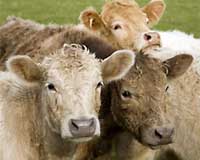 |
Canberra, Australia (SPX) Mar 23, 2010 As part of an international consortium, CSIRO scientists have played an important role in uncovering groundbreaking new information about Fusarium - a fungus capable of devastating cereal crops. The consortium showed that a disease-causing Fusarium can transfer part of its DNA to a normally benign Fusarium, turning it into a virulent pathogen. "Fusarium fungi are among the most destructive plant pathogens in the world and cause billions of dollars worth of losses in Australia and overseas every year," says the leader of the CSIRO Plant Industry team involved in the research, Dr Kemal Kazan. "By sequencing the DNA of Fusarium oxysporum and Fusarium verticillioides, and comparing them with that of Fusarium graminearum, our research consortium has been able to discover the innovative ways these fungi can change themselves." Fusarium graminearum affects wheat and barley and Fusarium oxysporum attacks many crops including cotton, tomato and banana. Fusarium verticilloides is a major corn pathogen. "Having a better understanding of which weapons Fusarium fungi use to attack crops will enable researchers to find new remedies to apply in agriculture," Dr Kazan said. Dr Kazan's team has already started decoding the DNA of Fusarium pseudograminearum - the crown rot pathogen - which costs Australian wheat and barley farmers $79 million in lost yield annually. CSIRO's part in the sequencing of Fusarium oxysporum closely follows the organisation's key role in mapping the pea aphid - one of a group of pests that also devastates crops around the world. The consortium's findings are published in the leading scientific journal, Nature. Approaching disease problems through local research and international collaborations is part of CSIRO's commitment to future food security and agricultural sustainability for Australia.
Share This Article With Planet Earth
Related Links CSIRO Farming Today - Suppliers and Technology
 The Environmental And Social Impact Of The Bovine
The Environmental And Social Impact Of The BovineStanford CA (SPX) Mar 23, 2010 Global meat production has tripled in the past three decades and could double its present level by 2050, according to a new report on the livestock industry by an international team of scientists and policy experts. The impact of this "livestock revolution" is likely to have significant consequences for human health, the environment and the global economy, the authors conclude. "The livest ... read more |
|
| The content herein, unless otherwise known to be public domain, are Copyright 1995-2010 - SpaceDaily. AFP and UPI Wire Stories are copyright Agence France-Presse and United Press International. ESA Portal Reports are copyright European Space Agency. All NASA sourced material is public domain. Additional copyrights may apply in whole or part to other bona fide parties. Advertising does not imply endorsement,agreement or approval of any opinions, statements or information provided by SpaceDaily on any Web page published or hosted by SpaceDaily. Privacy Statement |